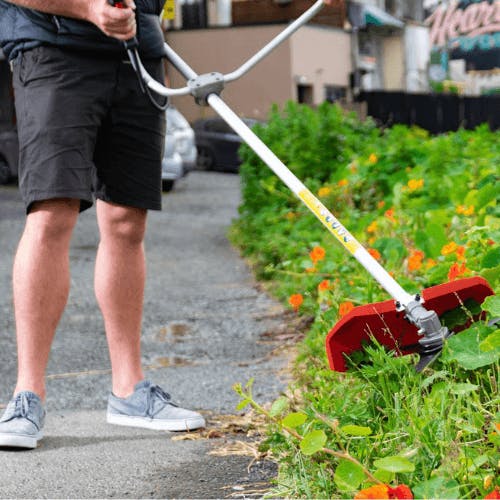- Home
- Buying Guides
- Brush Cutter Buying Guide
Brush Cutter Buying Guide
Looking to trim the backyard, clear some bush or undergrowth, or even cut down saplings? A brush cutter is a versatile tool that’s great for clearing your yard or larger areas. They’re strong, robust, and can offer excellent efficiency depending on the make. Before you buy a brush cutter, here’s what you need to know to choose the best model for your trimming needs.

Electric vs petrol brush cutters
What do you need to cut? If you’re just trimming a small suburban garden, an electric brush cutter or line trimmer could do the trick. But if you’re looking at regular lifestyle block use or need to tackle tougher tasks, like brush removal or heavy-duty trimming, stick with the petrol models. If you’re looking to save money and space at the same time, a petrol multi-tool could be your ultimate hand-held solution.
Brush cutter sizes
The greater the engine, the more powerful and effective your brush cutter will be at mowing large areas and tricky brush. At the same time, a powerful engine means a heavier machine, so you might want to opt for a lightweight model that’s more comfortable to use. All of our Flash brush cutters come with a harness, so no matter the job, you’ll have as little stress on your back as possible.
Brush cutter cutting attachments
Different blades can go a long way in cutting efficiency. Here are some of the cutting blades we offer at Trade Tested:
Safety
Before you start clearing and cutting, always follow these safety tips:
Maintenance
Regular maintenance will keep your brush cutter in its best condition:
Find robust brush cutters at Trade Tested
Get rid of weeds and bushes, or just give your garden edges a well-needed trim with a brush cutter from Trade Tested. As a trusted NZ garden improvement store, we offer a great selection of petrol brush cutters and electric line trimmers.
Check out our range today. Explore more garden tools, such as chainsaws and lawnmowers.
Still need more help? Either send us an email or give us a bell during office hours on 0800 800 880.
Browse Brush Cutters
Hear from our customers
“Easy to use, battery lasts well, and it covers a large area with ease. Highly recommend!”
“Very impressed with Flash Brush Cutter, have used a few times and does the job as good as the top brands.”
“Lightweight Brush Cutter, easy to assemble, easy start, easy handling. This was certainly a great buy, would recommend.”
Frequently asked questions
What’s the difference between a brush cutter and a line trimmer?
Brush cutters and line trimmers are both powerful tools that you can use to clear grass and weeds. The main difference is what they use for the task. Brush cutters can generally use both blades and line trimming heads, which can be switched out depending on the job expected. Line trimmers only use lines, which are good for trimming and thinning, but can get snagged on heavier brush.
Which brush cutter blade should you use?
When it comes to brush cutting blades, more teeth usually means more cutting power, perfect for heavy-duty work. If you’re just cleaning up some light grass, a line trimmer head can handle the job. Check out our cutting head attachment guide above for more details.
How do you install a brush cutter blade?
Always make sure your brush cutter is off before you change the cutting blade. Slot in the locking pin and unscrew the original blade. Put on the new blade, ensuring it's centred and in the correct direction. Add the washer, cup, and nut, and secure it with a wrench. Remove the locking pin and the blade’s safety guide. The exact installation instructions will depend on your brush cutter model, so be sure to read the included manual beforehand.
How do you sharpen a brush cutter blade?
Ensure your brush cutter is turned off and prop it up so that you can easily access the blade. Sharpen each tooth of the blade with a single-cut flat file, ensuring everything is equally sharp to maintain balance. 40-tooth cutting blades should only be sharpened by a professional.
How do you wear a brush cutter harness?
Put the harness on, making sure that the hip pad is by the side of your body, not the front. Clip the harness hook onto the brush cutter. Position your brush cutter so that it’s reasonably balanced when you hold it. The blade should not be high in the sky or dragging against the ground, either. Adjust the strap to tighten.
- Call Us 0800 800 880
Contact Centre
Our Contact Centre is open Monday to Saturday.
Locations
Our Auckland Store and Christchurch Showroom are open Monday to Saturday.
- Auckland Store
- 80 Kahakaha Lane
- Māngere
- Auckland 2022
- Christchurch Showroom
- 9 Commerce Crescent
- Islington
- Christchurch 8042
Payment
All prices are in NZD and include GST. We accept Visa, Mastercard, American Express, Apple Pay, Google Pay, bank transfer, Paypal and Afterpay. Credit card payments are fully secure. Payment methods.
Shipping
We use CourierPost, Fliway Transport, Team Global Express and Auckland Metro Freight. Shipping prices are shown on product pages and in the checkout.
Warranty & Returns
We offer a limited Return Policy and minimum 12 month Warranty on all products.